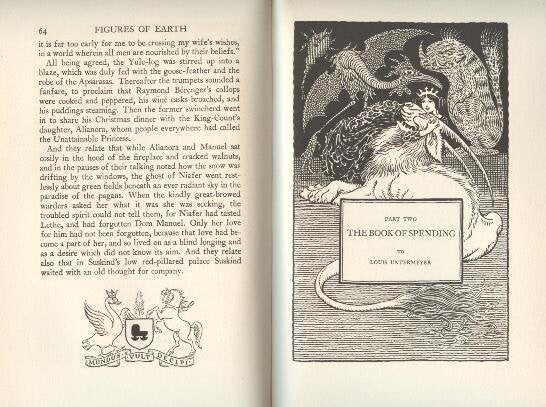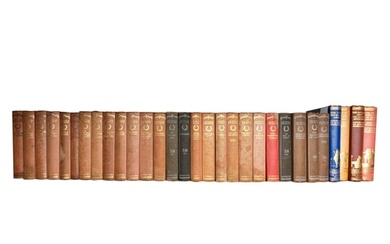Cabell, Figures of Earth, 1st/1st 1925, Pape illustrat.
"Figures of Earth, A Comedy of Appearances" by James Branch Cabell, Decorations and illustrations by Frank C. Pape, published by Robert McBride, New York, 1st Printing 1925. First illustrated Edition with numerous text illustrations, decorations, chapter headings and 12 plates on heavy paper. All 12 photogravure plates are present. The plates used in this edition were etched and printed in Great Britain and are the same as in first British edition.
Provenance:
Inside front cover is an ex-libris of Hebert B. Luria III (1907-1992), one of the owners of Luria Brothers Company. He was a graduate of Tome Preparatory School and attended Washington and Lee University. He served as Lieutenant during World War II.
The creation of the photogravure plate was a complicated process requiring a work by a photographer and experienced master-engraver. First, a copper plate was coated with a light-sensitive gelatin tissue which had been exposed to a film positive, and then etched, resulting in a high-quality intaglio print that can reproduce the detail and continuous tones of a photograph. It is a manual process.
In contrary to steel engravings, photogravures were engraved on copper plates and leave a plate impression in the paper. Due to relative softness of copper, the editions of photogravures were limited to a few thousand copies similarly to copper engravings and etchings.
Frank Cheyne Pape was born in 1878. Early in his career, while he was still working in color, Pape did illustrations for a series of fairy tale books "The Ruby Fairy Book" and he also did plates for "The Diamond Fairy Book" and "The Golden Fairy Book". These were probably done prior to WW1, because soon after the war, he would settle into the black & white style with which we're most familiar.
With the publication of the limited illustrated edition of "Jurgen" in 1921, Frank C. Pape became an "overnight" success. James Branch Cabell's 1919 novel had been the beneficiary of a suppression in New York on moral grounds and, of course, became his most famous work to date. Pape's illustrations were reproduced in photogravure for the plates and b&w for the images within the text. The plates debuted a new style and a device he was to use to great effect for years: an illustrated border below the main image. The frontispiece was to be one of his last published color paintings. Other Cabell books followed. A year or so after a new novel appeared, the Pape illustrated version was released. In addition, he illustrated two other Cabell books, "The Way of Ecben" (1929) and "Domnei" (1930).
With the success of "Jurgen", Pape was in demand to illustrate similar satire. Anatole France won the Nobel Prize for Literature in 1921 and his social satire was a perfect vehicle. Pape was commissioned to illustrate a uniform set of his most famous books. "At the Sign of the Reign Padauque" (1922), "The Revolt of the Angels" (1924), "Penguin Island" (1925), "Thais" (1926), "The Well of St. Clare" (1928), and "Mother of Pearl" (1929) were issued in the same black and gilt format as the Cabell books and are often mistaken for a matched set.
"Suetonius' Lives of the Twelve Caesars" (1930) was a major new translation with a strong suite of 16 plates in photogravure with only hints of humor. As was his 1927 "Complete Works of Doctor Francois Rabalais". But after a few titles in the early thirties: like "The Picture Story of Robinson Crusoe" (1933), "Tales From the Arabian Nights" (1934) and "Rachel the Immortal" (1935), his career came to a very abrupt stop.
JAMES BRANCH CABELL (1879-1958). American writer, Richmond (VA) author, several ironic fantasies he wrote took place in Cabell's mythical medieval world of Poictesme (Pwa-tem). "Jurgen" brought the reclusive writer national fame. Throughout the 1920s, Cabell was highly regarded by his literary peers -- H.L. Mencken, Sinclair Lewis, and others praised his works. His medieval romanticism and fantasy were in fact thinly disguised commentary on the manners of those times. By the end of his life he had authored some 52 volumes of work.
Today, some recognize Cabell as one of the first contemporary writers from the South. Like his friend and fellow Richmond writer Ellen Glasgow (1873-1945), Cabell was not afraid to satirize what he saw as the South's contradictions. Others, noting Cabell's unique blending of classic myths and legends with his own imagination, consider him a pioneer of fantasy writing. His work has been admired by a diverse group of writers, including Carl Van Vechten, Margaret Mitchell, Edmund Wilson, Robert Heinlein, and Neil Gaiman.
US: Priority (c.2-4 days) --------- $16.50
Canada: Priority (c.2-6 weeks) ---- $29.50
World: Priority (c.2-8 weeks) ----- $40.50
Condition Report: Original un-clipped dust jacket with price on the front flap (wear, edge damages); dust jacket is in mylar cover; hard boards, original black cloth decorated in gold; 6.1/2" x 9.3/4"; black illustrated endpapers; ex-libris [private book-plate] of Herbert B. Luria inside cover; 274 pages on high quality genuine laid paper, many b/w decorations and illustrations, 12 photogravure plates; fine pages; very good binding and condition.
View it on
Estimate
Time, Location
Auction House
"Figures of Earth, A Comedy of Appearances" by James Branch Cabell, Decorations and illustrations by Frank C. Pape, published by Robert McBride, New York, 1st Printing 1925. First illustrated Edition with numerous text illustrations, decorations, chapter headings and 12 plates on heavy paper. All 12 photogravure plates are present. The plates used in this edition were etched and printed in Great Britain and are the same as in first British edition.
Provenance:
Inside front cover is an ex-libris of Hebert B. Luria III (1907-1992), one of the owners of Luria Brothers Company. He was a graduate of Tome Preparatory School and attended Washington and Lee University. He served as Lieutenant during World War II.
The creation of the photogravure plate was a complicated process requiring a work by a photographer and experienced master-engraver. First, a copper plate was coated with a light-sensitive gelatin tissue which had been exposed to a film positive, and then etched, resulting in a high-quality intaglio print that can reproduce the detail and continuous tones of a photograph. It is a manual process.
In contrary to steel engravings, photogravures were engraved on copper plates and leave a plate impression in the paper. Due to relative softness of copper, the editions of photogravures were limited to a few thousand copies similarly to copper engravings and etchings.
Frank Cheyne Pape was born in 1878. Early in his career, while he was still working in color, Pape did illustrations for a series of fairy tale books "The Ruby Fairy Book" and he also did plates for "The Diamond Fairy Book" and "The Golden Fairy Book". These were probably done prior to WW1, because soon after the war, he would settle into the black & white style with which we're most familiar.
With the publication of the limited illustrated edition of "Jurgen" in 1921, Frank C. Pape became an "overnight" success. James Branch Cabell's 1919 novel had been the beneficiary of a suppression in New York on moral grounds and, of course, became his most famous work to date. Pape's illustrations were reproduced in photogravure for the plates and b&w for the images within the text. The plates debuted a new style and a device he was to use to great effect for years: an illustrated border below the main image. The frontispiece was to be one of his last published color paintings. Other Cabell books followed. A year or so after a new novel appeared, the Pape illustrated version was released. In addition, he illustrated two other Cabell books, "The Way of Ecben" (1929) and "Domnei" (1930).
With the success of "Jurgen", Pape was in demand to illustrate similar satire. Anatole France won the Nobel Prize for Literature in 1921 and his social satire was a perfect vehicle. Pape was commissioned to illustrate a uniform set of his most famous books. "At the Sign of the Reign Padauque" (1922), "The Revolt of the Angels" (1924), "Penguin Island" (1925), "Thais" (1926), "The Well of St. Clare" (1928), and "Mother of Pearl" (1929) were issued in the same black and gilt format as the Cabell books and are often mistaken for a matched set.
"Suetonius' Lives of the Twelve Caesars" (1930) was a major new translation with a strong suite of 16 plates in photogravure with only hints of humor. As was his 1927 "Complete Works of Doctor Francois Rabalais". But after a few titles in the early thirties: like "The Picture Story of Robinson Crusoe" (1933), "Tales From the Arabian Nights" (1934) and "Rachel the Immortal" (1935), his career came to a very abrupt stop.
JAMES BRANCH CABELL (1879-1958). American writer, Richmond (VA) author, several ironic fantasies he wrote took place in Cabell's mythical medieval world of Poictesme (Pwa-tem). "Jurgen" brought the reclusive writer national fame. Throughout the 1920s, Cabell was highly regarded by his literary peers -- H.L. Mencken, Sinclair Lewis, and others praised his works. His medieval romanticism and fantasy were in fact thinly disguised commentary on the manners of those times. By the end of his life he had authored some 52 volumes of work.
Today, some recognize Cabell as one of the first contemporary writers from the South. Like his friend and fellow Richmond writer Ellen Glasgow (1873-1945), Cabell was not afraid to satirize what he saw as the South's contradictions. Others, noting Cabell's unique blending of classic myths and legends with his own imagination, consider him a pioneer of fantasy writing. His work has been admired by a diverse group of writers, including Carl Van Vechten, Margaret Mitchell, Edmund Wilson, Robert Heinlein, and Neil Gaiman.
US: Priority (c.2-4 days) --------- $16.50
Canada: Priority (c.2-6 weeks) ---- $29.50
World: Priority (c.2-8 weeks) ----- $40.50
Condition Report: Original un-clipped dust jacket with price on the front flap (wear, edge damages); dust jacket is in mylar cover; hard boards, original black cloth decorated in gold; 6.1/2" x 9.3/4"; black illustrated endpapers; ex-libris [private book-plate] of Herbert B. Luria inside cover; 274 pages on high quality genuine laid paper, many b/w decorations and illustrations, 12 photogravure plates; fine pages; very good binding and condition.




